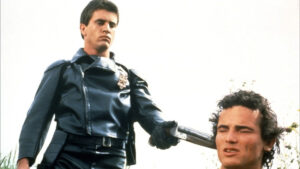Publication Date: 05-20-2024
Mad Max (1979) review
Dir. George Miller
By: Steve Pulaski
Rating: ★★½
George Miller’s Mad Max is a pioneer in low-budget, action filmmaking, proving to mainstream audiences that multiple million dollar production budgets and advertising campaigns aren’t a requirement when making a high-octane film. Even decades later, as Mad Max‘s once-crystal clear aesthetic has become more or less a representation of the sun-soaked age that one equates with seventies films, it manages to impress because of how coordinated the stunts had to be for reasons other than safety. Due to such a low budget (only around $400,000), stunts had to be done precisely right the first time, for reshoots were costly and unforeseeable with a menial budget.
This fact alone could’ve rendered Mad Max nothing more than an obscure foreign b-movie that was lucky enough to get a wider release in the United States. Even some of the most impressive b-movies – Duel and Killer Klowns from Outer Space come to mind in terms of trying to do a great deal with very little – went on to live in obscurity and merit little cultural impact. Mad Max is the epitome of a surprise hit, spawning not only a franchise, but a career for one of the most successful actors, writers, and directors in history.
We are plunged into a dystopian Australia in the not-so-distant future. Law and order, and society in general, has begun to break down in favor of chaos thanks to an energy crisis, leaving large metropolitan cities as the only ones who are able to survive. We spend most of our time in the Australian Outback, following a dangerous motorcycle gang known as The Acolytes as they terrorize passersby with their large vehicles and weaponry. At the center of all the camaraderie is Max (Mel Gibson), a police officer desperately trying to maintain structure and peace in his homeland. Soon after the chaos worsens, Max realizes that the only way to save his once peaceful homeland is to kill all the members of the motorcycle gang, led by two men known as “Toecutter” (Hugh Keays-Byrne) and Bubba Zanetti (Geoff Parry).
Max’s realization of the problem and method of action comes at the expense of his own personal ethics, which, we can kind of assume, were pacifistic up until this point. It’s the classic case of a movie character being pushed to his limits, realizing that the only way to fight the power is to play along rather than sit back and hope everything will work itself out thanks to a lack of interference and increased passivity.
Gibson plays an intriguing character with a fascinating moral complex, who, unfortunately however, isn’t explored as much as he could be. His moral dilemma is downplayed in favor of the violent scenarios often occurring on screen, so much so that there is a disconcerting lack of character interest for our title character. Furthermore, the film’s pacing feels off for much of the film, leaving the first sixty or seven minutes sort of deciding between wading in the water and throwing caution to the wind. At times, in the beginning, we can see director/co-writer George Miller and James McCausland attempt to weave a slowburn pacing style in with Mad Max‘s increasing amount of blunt force. However, Miller and McCausland cannot seem to commit to one or the other, and that leaves a film that transitions back and forth from extreme action to a humble focus on Australia’s barren landscape.
These changes take Mad Max down a few notches, especially considering that during these scenes of combat and action, we can’t extract much else from them other than how brutal they can be. The moments spliced in between the action give us time to extract ideas, character traits, and personalities from those involved, and when there is a middling amount of that and displays of action impressive because of their spontaneity and capabilities, there’s a looming emptiness to the film as a whole.
Mad Max gets a large amount of style points, however, on part of Miller, who directs it with complete conviction and a respect for Australia’s elegant, natural beauty. We are thrown into this world feet first, given little time to learn the politics of the road before heavily-armed muscle cars and motorcycles roar past us. This narrative technique and the scenery, made attractive by its ugliness, all work in the film’s aesthetic favor. There is an unshakeable level of menace and vengeance to this particular story that could’ve bled through in mass amounts had our title character been more of a character rather than a force, or, paradoxically, just a title.
NOTE: As of this writing, Mad Max is available to stream on Pluto TV, free of charge.
My review of Mad Max 2: The Road Warrior
My review of Mad Max Beyond Thunderdome
My review of Mad Max: Fury Road
My review of Furiosa: A Mad Max Saga
Starring: Mel Gibson, Hugh Keays-Byrne, and Geoff Parry. Directed by: George Miller.
About Steve Pulaski
Steve Pulaski has been reviewing movies since 2009 for a barrage of different outlets. He graduated North Central College in 2018 and currently works as an on-air radio personality. He also hosts a weekly movie podcast called "Sleepless with Steve," dedicated to film and the film industry, on his YouTube channel. In addition to writing, he's a die-hard Chicago Bears fan and has two cats, appropriately named Siskel and Ebert!


